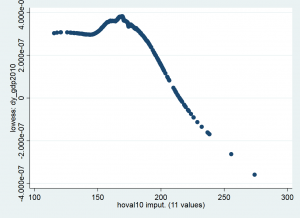This page provides links to various software that I have created over time. Many of them are ado files for Stata
Egohoods ado package:
Stata code to create your own egohoods is here. This is an explicitly spatial approach that constructs overlapping neighborhoods, as opposed to the more traditional approach of constructing non-overlapping neighborhoods.
krlsplots ado package:
This ado file creates plots after estimating a model using Kernel-regularized least squares (KRLS). You need to obtain the KRLS ado package separately from this. This ado file creates various Lowess plots by regressing the estimated derivatives on the variables in the model. This was demonstrated and described in this published article:
This krlsplot.ado package determines which variable(s) are most strongly associated with a set of derivatives by regressing the derivatives on the variable and its squared and cubed versions. The user defines a cutoff r-square value for retaining a particular plot.
You can download the ado file, the example do file and dataset, and the documentation here. They are in a zipped file. Or you can download the krlsplot.ado file directly.
See the KRLSplots_documentation.pdf file for instructions on how to use.
Here is what an example plot looks like.
Computing intergroup relations
When computing rates for intergroup relations (for example, violent events between groups), it is important to correctly compute the denominator for such rates. Most prior work does this incorrectly. This article discusses this issue: Hipp, John R., George E. Tita, and Lyndsay N. Boggess. (2011). “A new twist on an old approach: A random-interaction approach for estimating rates of inter-group interaction.” Journal of Quantitative Criminology 27(1): 27-51. Here is some Stata code to create these measures to either use as the denominator when computing a rate (e.g., a crime rate) or as an exposure variable when estimating a Poisson model.
SAS macro for Tetrad tests with non-continuous variable
Hipp, John R., Daniel J. Bauer, and Kenneth A. Bollen (2005). “Conducting Tetrad Tests of Model Fit and Contrasts of Tetrad-Nested Models: A New SAS Macro.” Structural Equation Modeling. 12(1): 76-93. The SAS macro and documentation for ctanest1.mac for performing model fit for Structural Equation Models with non-continuous variables can be downloaded here.
This is based on the work in “Model Fit in Structural Equation Models with Censored, Ordinal, and Dichotomous Variables: Testing Vanishing Tetrads”. Sociological Methodology. 33: 267-305. (with Kenneth A. Bollen).
